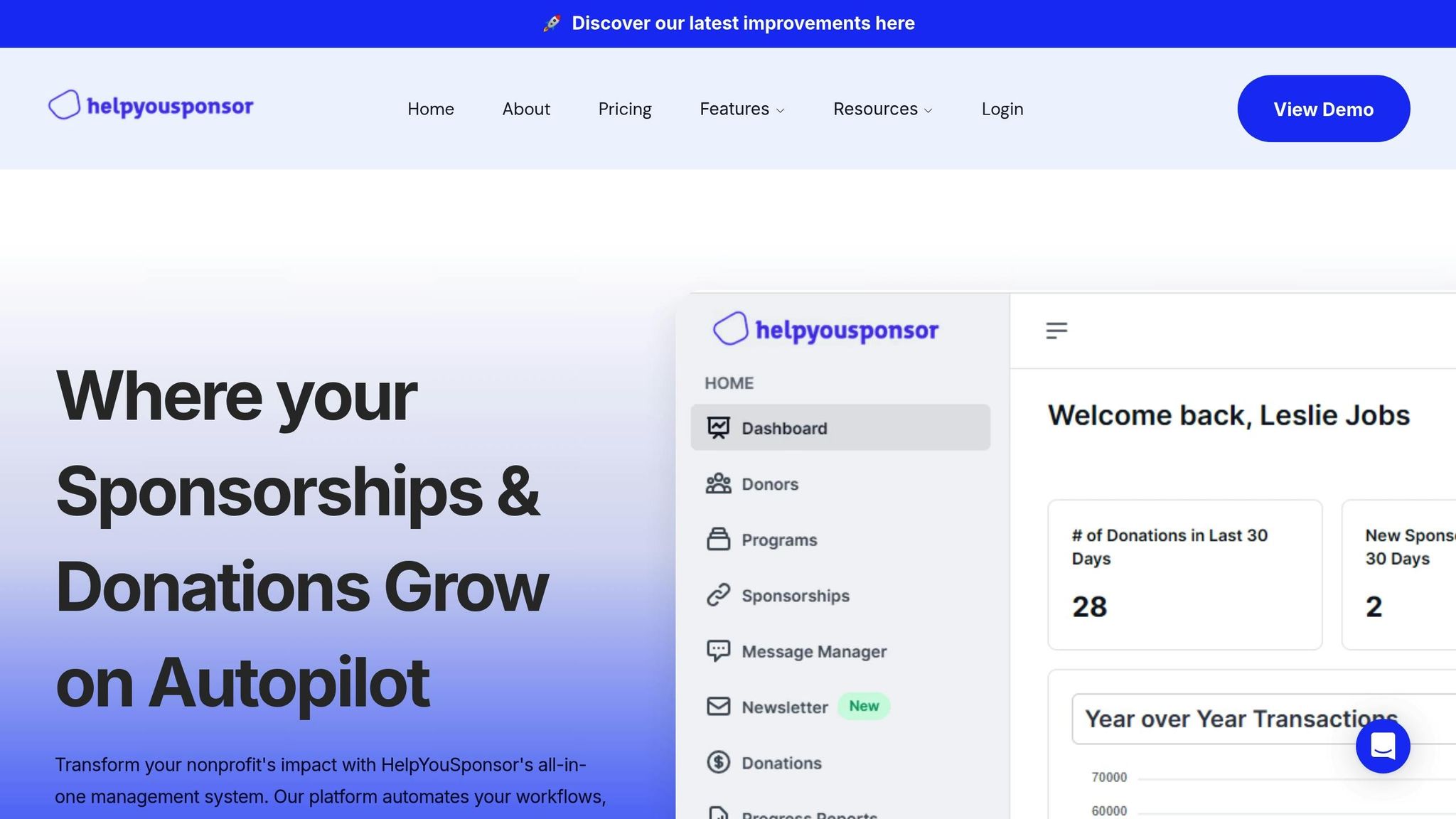How to Build Strong Partnerships with Child Protection Agencies
Learn how to build effective partnerships with child protection agencies to enhance child safety and support vulnerable families.

Building effective partnerships with child protection agencies is essential to safeguarding children. These collaborations bring together nonprofits and child protection services to improve risk identification, streamline efforts, and provide critical support for vulnerable children. Here's how to create and maintain these partnerships:
- Understand Roles: Child protection agencies focus on investigations, legal matters, and family preservation, while nonprofits offer services like counseling, shelters, and education.
- Research Potential Partners: Study their policies, leadership, and collaboration history to ensure alignment with your goals.
- Define Shared Goals: Align missions, clarify roles, and agree on prevention-focused strategies to avoid duplication of efforts.
- Formalize Agreements: Develop written agreements outlining roles, responsibilities, and dispute resolution processes.
- Maintain Communication: Regular meetings, shared systems, and open dialogue ensure smooth collaboration.
- Joint Training: Train staff together to build mutual understanding and improve child safety practices.
- Engage Families and Communities: Include families in decision-making and involve local communities to strengthen support systems.
- Leverage Digital Tools: Platforms like HelpYouSponsor simplify operations, protect data, and enhance collaboration, allowing teams to focus on child protection.
Partnership working in child protection
What Child Protection Agencies Do
Child protection agencies serve as the first line of defense across the United States, stepping in swiftly to address cases of abuse and neglect where intervention is critical.
Main Duties of Child Protection Agencies
Child Protection Services (CPS) agencies have a range of responsibilities designed to ensure the safety and well-being of children. Their primary role is to investigate reports of abuse and neglect, determining whether children are safe while trying to balance family preservation with protection needs.
The scope of their work is immense. In 2020 alone, CPS staff assessed approximately 3.9 million children, gathering information from reports, court filings, arrest records, and conducting interviews with children, parents, and other key individuals .
When children cannot remain safely in their homes, CPS steps in to arrange alternative living situations, often placing children with relatives or foster families. For those removed from their homes, CPS provides ongoing care under the supervision of Juvenile Dependency Courts. They also focus on long-term solutions, whether through reunification with families or by finding permanent placements like adoption for children leaving foster care.
Beyond these immediate interventions, CPS prioritizes prevention by offering family support services to address risks before they escalate. They work closely with law enforcement during investigations, particularly when criminal activity is involved.
These responsibilities highlight the need for additional support from nontraditional resources to complement CPS expertise.
How Partnerships Improve Child Safety
While CPS agencies have clearly defined roles, their effectiveness increases significantly through partnerships with other organizations. Collaboration allows for a broader safety net, filling gaps that CPS alone cannot address.
Nonprofits play a crucial role in this ecosystem, stepping in to provide services that extend beyond CPS’s investigative and legal responsibilities. These organizations operate crisis centers, emergency shelters, 24-hour helplines, and offer long-term rehabilitation services like counseling, mentorship, and educational programs to help children recover from trauma.
The National Children's Alliance offers a great example of how partnerships can work. Their network supports 939 Children's Advocacy Centers (CACs) across the country, which collectively served over 386,000 children in 2021. These centers unite CPS workers, law enforcement, prosecutors, and nonprofit service providers under one roof, streamlining investigations and treatment.
"The Gingerbread House is a safe haven - a soft place to land - for children who have been hurt through physical or sexual abuse. We are essential first responders in child abuse investigations", says Jessica Milan Miller, CEO of the Gingerbread House Children's Advocacy Center.
Collaborating with nonprofits not only expands resources but also brings in specialized expertise. CPS agencies contribute legal authority, investigative skills, and access to court systems, while nonprofits provide trauma therapy, community outreach, and culturally sensitive approaches. Together, they ensure more thorough assessments and interventions tailored to each child’s needs.
These partnerships also focus on prevention by addressing the root causes of child welfare involvement. By working with behavioral health services, Medicaid, public health organizations, schools, and social service systems, CPS agencies and their partners can meet family needs before crises arise. This multi-faceted approach tackles systemic issues that contribute to abuse and neglect.
Joint training initiatives further strengthen these collaborations. Nonprofits, for instance, can train CPS staff on recognizing abuse, handling sensitive cases, and following legal reporting procedures.
The benefits of these partnerships go beyond individual cases, driving systemic improvements. Sheriff Steve Prator of Louisiana's Caddo Parish describes Children's Advocacy Centers as "a godsend for children, families, and the entire criminal justice system". This sentiment underscores how collaboration makes child protection efforts more effective, benefiting everyone involved.
How to Build Strong Partnerships
Establishing strong partnerships with child protection agencies requires careful planning and collaboration. Success hinges on thorough preparation, shared goals, and clearly defined agreements that outline how both organizations will work together effectively.
Research Potential Partners
The first step in building a partnership is conducting in-depth research. This groundwork can determine whether the collaboration will thrive or face challenges.
Start by examining the agency’s policies, values, and safeguarding practices. Review their annual reports, mission statements, and public records to get a sense of their approach to child welfare. Look for transparency in their operations and a solid reputation within the community.
Take note of their current programs and services to identify areas where your organization’s strengths can complement their efforts. For example, the Administration for Children and Families (ACF) supports a range of services - such as child care, family assistance, and child welfare - through state, local, and tribal organizations. Understanding an agency’s focus helps you position your nonprofit’s contributions in a way that aligns with their priorities.
Learn about their leadership and key personnel. Identify individuals who could champion your partnership, whether they hold leadership roles or are influential in fostering collaboration among stakeholders.
Finally, investigate their history of collaboration by reaching out to other nonprofits that have worked with them. Insights into their partnership style, communication methods, and reliability can help you assess their suitability as a partner.
Once you’ve identified potential partners, ensure your missions and values align before moving forward.
Match Your Missions and Goals
For a partnership to succeed, both organizations must share common goals, especially when it comes to child safety. Start by clearly defining your nonprofit’s mission, goals, and strengths. Be specific about what your organization brings to the table, whether it’s trauma therapy, emergency shelter services, or community outreach programs. This clarity will help you communicate your role in the partnership.
Work with potential partners to develop a shared vision, mission, and values that prioritize prevention. This process often involves multiple discussions to align on approaches to child safety, family involvement, and community engagement.
Focus on prevention-driven partnerships, recognizing that no single organization can tackle child protection alone. For instance, your nonprofit might specialize in addressing the root causes of abuse through community programs, while the child protection agency offers legal authority and investigative expertise. Together, you can create a greater impact.
Respect for each organization’s role is essential. Child protection agencies handle investigations and legal matters, while nonprofits often provide specialized services like counseling or mentorship. Avoiding territorial disputes ensures a smoother collaboration.
Encourage family engagement by involving families in the design and implementation of services. Both organizations should agree on how families will participate in decision-making to safeguard children effectively.
Once you’ve established shared goals, formalize the partnership with a written agreement.
Create Written Agreements
Formal agreements are the backbone of a successful partnership. These documents prevent misunderstandings and set clear expectations for both parties.
Partnership agreements should be developed collaboratively. Each organization brings unique operational styles, funding requirements, and regulatory needs, which should be reflected in the agreement.
Start with a base agreement and adapt it to fit each partner’s specific needs. As one Head Start/Early Head Start director from the Mid-Willamette Valley Community Action Agency explained:
"It's not a cookie cutter. Each provider has different pay rates, different agreements about staffing, etc. We had to work individually with every partner. We had to meet them where they were and provide them with what it was that they needed most. We also sought to incorporate their values into the agreement."
Clearly outline roles, responsibilities, service targets, and training commitments. This level of detail ensures both parties understand their obligations.
Draft agreements iteratively. One child care coordinator from the Salem-Keizer Teen Parent Program shared their experience:
"We probably went back about 15 different times and sat down and went through the contract, back and forth…. I really felt like we were a team, trying to make this happen."
Include key elements like dispute resolution procedures and confidentiality clauses. These sections are essential for addressing disagreements or safeguarding sensitive information.
Keep agreements flexible. Build in regular review periods to assess progress and adjust terms as needed. Collaborative structures, like umbrella entities or regular meetings, should also be included in the agreement to ensure consistent communication between organizations.
How to Keep Partnerships Strong
Building partnerships is just the beginning - keeping them strong requires ongoing collaboration, shared learning, and active community involvement. These elements are key to creating a lasting impact on child safety.
Stay in Touch and Work Together
Regular communication is the backbone of any strong partnership. Schedule routine meetings with child protection agency partners to discuss ongoing cases, evaluate progress, and address new challenges as they arise.
"Frequent communication from YSO leadership to all constituencies (including parents) about its commitment to child abuse prevention and to child/youth safety helps to ensure that supervisors, staff and volunteers are not only aware of the requirements, but also helps to build ongoing awareness, sustain vigilance, and create an environment where unsafe practices are noticed because they are not the norm, and where they can be corrected before a child or youth is harmed. Communication and support from leadership helps to transform policy into practice."
Active listening plays a huge role in building trust. When partners share concerns or suggestions, give them your undivided attention and confirm that you’ve understood by summarizing their points. To keep everyone aligned, consider creating shared information systems that break down silos. Use a mix of communication tools - newsletters, digital platforms, and informal check-ins - to maintain an open dialogue. Also, make sure communication is accessible by using clear language, providing interpreters if needed, and offering materials suitable for families with different literacy levels.
Keeping communication consistent sets the stage for effective collaborative training.
Train Staff and Build Skills Together
Joint training sessions are a great way to build mutual understanding and strengthen teamwork across organizations. A standout example of this approach comes from the Collaborative for Educational Services in Massachusetts. In 2014, through its System Change for Successful Children project, the organization developed toolkits and training sessions for child protection professionals and early educators. These cross-training efforts improved collaboration between early childhood education and child protection systems.
"Engage in ongoing joint trainings...Joint training opportunities on topics of mutual interest (such as mandated reporting, administering and interpreting assessments, and working with high-needs families) can provide opportunities to establish relationships and develop a common understanding of each other's terminology, policies, and services."
Focus your training on areas like trauma-informed care, mandated reporting, family engagement strategies, and working with families facing significant challenges. Cross-training allows staff from different organizations to better understand each other's roles, which leads to stronger collaboration and better outcomes for children. Regular training sessions also help ensure that organizational goals are reflected in day-to-day practices.
Include Families and Communities
Partnerships become even stronger when families and communities are actively involved. Families bring unique insights about their children, making their input essential for designing and implementing effective programs. Recognizing their contributions - such as compensating them for their time - further enhances these efforts.
Jack Auzinger, a Youth Council member, emphasized the value of youth-driven programs, highlighting how peer-to-peer mentoring can make a difference.
Engaging the broader community creates a support network that goes beyond what individual organizations can offer. Start by mapping out local resources and identifying potential partners. Small pilot projects can help build trust with community members, while offering various ways to participate - like volunteering, advisory roles, or governance positions - can encourage deeper involvement.
"We need to move from dynamic leaders to dynamic systems, so that collaboration is in the DNA of the system" – Interviewee from California
Establish regular feedback channels with families and community members to gather input and identify areas for improvement. Stay flexible and responsive to community needs to ensure partnerships remain effective and relevant. Ultimately, strong family and community engagement supports a multi-agency approach, which is critical for protecting children.
Using Digital Tools for Better Partnerships
Modern technology is changing the way nonprofits collaborate with child protection agencies by simplifying communication, automating repetitive tasks, and safeguarding sensitive information. This allows organizations to focus more on building meaningful partnerships and increasing their impact. Platforms like HelpYouSponsor are leading the way with practical, user-friendly features that make these benefits a reality.
What HelpYouSponsor Offers

HelpYouSponsor is designed to streamline operations through centralized data management, integrated messaging, and secure document sharing. By automating 90% of sponsorship management tasks, it saves organizations over 20 hours each week - time that can be redirected toward strategic initiatives and program development.
- Centralized Data Management: Gone are the days of juggling spreadsheets and scattered files. HelpYouSponsor consolidates donor interactions, sponsorship details, and program outcomes into one secure platform. This streamlined approach is especially helpful when working with child protection agencies, as it ensures consistent data sharing and reduces the chances of errors or miscommunication.
-
Integrated Messaging Systems: The platform connects all stakeholders through automated updates and real-time notifications. Farrell Burton, Director of Operations at Hope Project International, shared how this feature has supported their mission since 2014:
"Through this program, we can provide education, healthcare, and basic needs, giving children a brighter future... This program has been instrumental in connecting sponsors with children, allowing us to efficiently manage donations, track progress, and ensure every child receives the care they deserve."
- Secure Document Sharing: With role-based access controls and data encryption, sensitive information about children and families stays protected. At the same time, authorized personnel can easily access the documents they need. The platform also integrates with tools like Stripe, Mailchimp, and Zapier, creating a seamless workflow that supports existing processes.
Currently, over 1,500 users rely on HelpYouSponsor to manage more than $19 million in donations. Organizations report an average 3.8x increase in sponsorships after adopting the platform. Danny Cunningham, President of 4 Him in Africa Ministries Inc., highlighted the operational benefits:
"Being able to turn the daily operating duties over to a program that runs in the background of our website was an answer to prayer. I am sure more children were able to get an education because of what 'HelpYouSponsor' added to our non-profit."
These features not only reduce administrative workloads but also strengthen partnerships by fostering clear communication and ensuring data security.
Why Digital Tools Help
Digital tools like HelpYouSponsor simplify sponsorship management, improve communication, and ensure data security. Automation takes care of routine tasks, while donor self-service portals ease administrative burdens. Advanced security features, such as audit trails and encryption, protect sensitive information, building trust between nonprofits and child protection agencies.
Amanda Jones, Database Administrator at Accordus, shared her positive experience:
"My experience with the Help You Sponsor platform has been outstanding. The support team has gone above and beyond to ensure our needs are met every step of the way."
The platform also offers customizable dashboards and reporting tools, helping organizations measure their success and showcase their impact to stakeholders. Sherlyn Comia from Sisters of Mary World Villages for Children added:
"Working with HelpYouSponsor has been a super fantastic experience... Interactions with the team are very thoughtful, efficient and professional, and it feels like they truly care about the success of our program. Truly grateful for their support! Highly recommended!"
To make these tools accessible for organizations of all sizes, HelpYouSponsor offers flexible pricing options: a free plan for new organizations, a Pro plan at $39/month, and a Max plan at $0.50 per commitment. This ensures that nonprofits can benefit from digital tools regardless of their budget.
Conclusion: Working Together for Child Safety
Building strong partnerships demands commitment, open communication, and a shared focus on protecting children. Data from the Child Welfare Community Collaborations initiative reveals that grantees typically collaborate with around 20 organizations, with half of these being community-serving groups.
"Successful outcomes for children depend on strong partnership working between parents/carers and the practitioners working with them." - Safeguarding Partnership Principles
To make these collaborations effective, clear interagency agreements, regular meetings, and joint training sessions are essential. These steps help eliminate confusion and foster accountability. These practices align with earlier strategies - such as conducting thorough research, aligning missions, formalizing agreements, collaborative training, and integrating digital tools - to create a comprehensive safety net for children.
Digital solutions like HelpYouSponsor play a pivotal role by automating routine processes, safeguarding sensitive data, and improving communication. This allows organizations to redirect their resources toward direct child protection efforts. By simplifying operations, these tools strengthen the effectiveness of every partnership.
Engaging families and communities is equally critical. Active participation builds trust and creates a support system that can prevent crises before they occur. Continuous evaluation of these efforts ensures that partnerships remain adaptable and effective in addressing evolving challenges.
"Collaborative partnerships are essential for community-driven strategies that prevent child maltreatment, yet they present complexities that must be navigated." - Approaches to Collaborative Partnerships in the Child Welfare Community Collaborations Initiatives
As organizations move forward, they must prioritize regular assessments of their collaborative efforts to pinpoint areas for improvement. This ongoing evaluation ensures that resources are used efficiently and that partnerships can adjust to meet changing needs. Building strong partnerships takes time, adaptability, and a willingness to learn continuously.
The overarching goal is clear: to create a robust network of support that protects children, empowers families, and strengthens communities. Together, organizations can achieve what none could accomplish alone.
FAQs
What steps should nonprofits take to establish a partnership with a child protection agency, and why are written agreements essential?
To work effectively with a child protection agency, nonprofits should prioritize open communication, shared objectives, and formal agreements. Start by fostering trust through honest conversations, clearly defining mutual goals, and outlining each party's responsibilities to ensure alignment.
Having a written agreement is crucial. These documents set clear expectations, formalize the partnership, and serve as a guide for addressing any misunderstandings. While not legally binding, they create accountability, safeguard everyone involved, and support a collaborative effort to protect children. A well-crafted agreement lays the groundwork for a smoother and more effective partnership.
How can tools like HelpYouSponsor improve partnerships between nonprofits and child protection agencies?
Digital platforms like HelpYouSponsor are transforming the way nonprofits and child protection agencies work together. By making communication smoother and simplifying how data is shared, these tools help both groups coordinate their efforts more efficiently. They also offer real-time tracking and reporting features, which means safeguarding concerns can be addressed without delay.
On top of that, these platforms improve how resources are managed and boost collaboration. They allow nonprofits and agencies to exchange insights and share effective strategies, strengthening child protection programs. Over time, this fosters trust and builds stronger, lasting partnerships between organizations.
What role do families and communities play in partnering with child protection agencies, and how can they be engaged effectively?
Families and communities play a crucial role in working alongside child protection agencies to ensure children's safety. Their involvement helps build nurturing environments that support both the well-being and protection of children.
To connect with families and communities in meaningful ways, start by building trust through open communication and focusing on their strengths. Partnering with local organizations and community leaders can bring in valuable resources and support. Additionally, adopting trauma-informed approaches ensures families feel heard, respected, and empowered. When everyone works together, these partnerships can make a big difference in keeping children safe.

